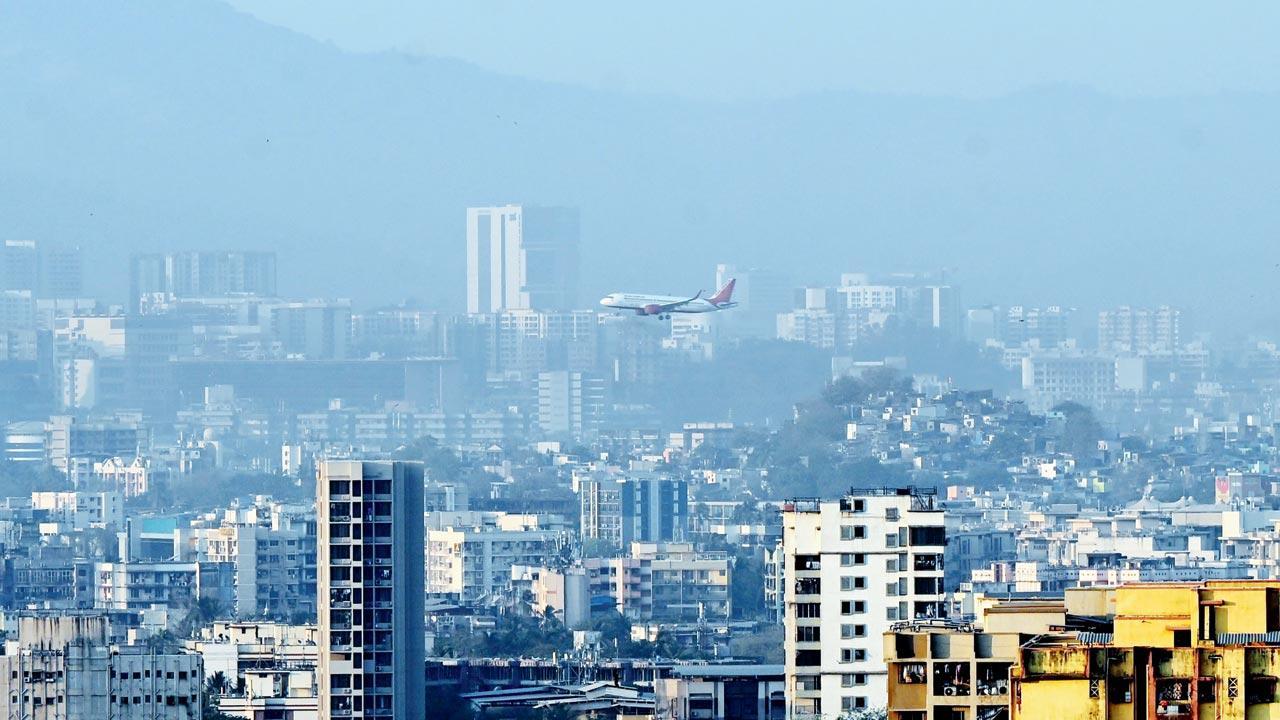Govt plans to ease height restrictions near airport, but approval hurdles remain

Aircraft preparing to land at the Mumbai airport in Andheri. File pic/Kirti Surve Parade
If everything goes as planned, the state government may soon issue a notification allowing taller buildings in areas around Mumbai airport, which currently fall under the funnel zones. At present, areas like Vile Parle, Santacruz, and Kurla have height restrictions due to their proximity to the airport’s flight landing and takeoff path.
ADVERTISEMENT
On Wednesday, March 26, Deputy Chief Minister Eknath Shinde, who also holds the portfolio of Urban Development, Housing, and Public Works (Public Enterprises), announced in the Assembly an amendment to the DCPR (Development Control and Promotion Rules – 2034). This amendment will lift height restrictions in funnel zones, allowing redevelopment.
Though an official government notification is awaited, some experts believe that even if the state government announces the relaxation, a No Objection Certificate (NOC) from the Civil Aviation Ministry and DGCA, which fall under the Central government, will be both inevitable and binding.
 Advocate Shreeprasad Parab, Expert Director, State Housing Federation
Advocate Shreeprasad Parab, Expert Director, State Housing Federation
Since the Assembly announcement, there has been a wave of excitement among residents of these areas. However, some housing experts caution that it is better to wait and watch, as the announcement could be a political move ahead of the upcoming BMC elections.
But what does this announcement, actually mean, to decode the same, mid-day reached out to Advocate Shreeprasad Parab, expert director, Maharashtra State Housing Federation
What is a Funnel Zone?
A funnel zone is an area near an airport where planes take off and land. Because of this, there are strict height restrictions on buildings to ensure flight safety.
Redevelopment challenges
In localities such as Santacruz, Vile Parle, and Kurla, many old buildings require redevelopment. However, due to funnel zone height restrictions, developers cannot construct taller buildings, making redevelopment financially unviable. Since the entire available Floor Space Index (FSI) cannot be utilised, many buildings remain in a deteriorated state, forcing residents to live in unsafe conditions.
What is redevelopment?
Redevelopment involves demolishing old or dilapidated structures and constructing new buildings on the same land. This can be done by private developers or through self-redevelopment, utilising FSI or Transferable Development Rights (TDR) as per the Development Control Regulations (DCR). Currently, Mumbai’s DCPR-2034 requires an NOC from Civil Aviation Authorities for any construction in funnel zones due to height restrictions, limiting the use of FSI and TDR.
Deputy CM’s announcement
On March 26, Deputy CM Eknath Shinde announced a special concession scheme for redevelopment in funnel zones. The scheme allows the transfer of development potential in the form of TDR to other projects, enabling the sale of unutilised FSI. It also provides concessions on open space deficiency premiums and exempts areas like staircases and lifts from FSI calculations.
What is TDR?
TDR (Transfer of Development Rights) allows property owners to transfer or sell unutilised FSI. For example, if a plot in Vile Parle East has the potential for a 10-floor building but height restrictions cap it at six floors, the remaining four floors’ FSI can be transferred or sold as TDR. Post recent announcement of the Dy CM and once implemented, the developer/owner of the plot can utilise the unused FSI of four floors, in the form Development Right Certificate (DRC) which mentions the FSI credit or unused in the form of TDR, thereby transferring or selling the Development Right from one plot to another plot or to anyone who is intending to buy such unused FSI for construction, as per the DCPR provisions.
How is TDR Valued?
TDR values range from 65 per cent to 85 per cent of the prevailing market rate, determined by demand and supply. It can be sold to any buyer willing to pay the required amount. TDR functions like a financial asset that can be liquidated when needed.
DGCA approval needed
If a significant portion of flights shift to the Navi Mumbai airport, air traffic patterns may change, leading to a review of height restrictions. However, any modification in height limits will require:
1. DGCA (aviation authority) approval
2. Revised obstacle limitation charts (OLC)
3. Coordination between urban planning, aviation, and local government bodies
Once the Navi Mumbai airport is fully operational and air traffic shifts significantly, there is a possibility of relaxed height regulations.
Future of redevelopment
Housing societies currently unable to proceed with redevelopment due to height restrictions may, after policy approval, utilise available FSI within the restricted height limits while selling the remaining development potential as TDR in the open market. If further height relaxations occur in the future, the unsold FSI can be used for the same project, making redevelopment more viable.
Self-redevelopment
Mumbai faces a severe affordable housing crisis, with skyrocketing real estate prices forcing people out of their communities. Self-redevelopment offers housing societies an alternative to traditional builder-led redevelopment, allowing them to modernise their homes while retaining full control over the project.
Mar 26
Day announcement was made in Assembly
Advantages of self-redevelopment
. Higher carpet area for members
. Better amenities and infrastructure
. No builder interference – full control with society members
. Higher profits for members as additional flats can be sold by the society
. Reduced delays compared to builder-led redevelopment
. Government support and loan availability
If self-redevelopment is implemented effectively, it can lead to more sustainable and affordable housing projects, benefiting both existing residents and potential homebuyers.
Suggestions by state federation
The Federation has welcomed the state government’s decision to allow TDR sales and has put forward additional recommendations, including:
. Implementing a single-window system for approvals within 30 minutes, including RERA registration for projects.
. Real-time monitoring of projects using cameras, with daily progress updates on an official portal to prevent fraud and disputes.
. Setting up demonstration and educational studios to train societies in green and sustainable construction.
. Directing NCDC or MCDC to provide seed funding for self-redevelopment projects.
 Subscribe today by clicking the link and stay updated with the latest news!" Click here!
Subscribe today by clicking the link and stay updated with the latest news!" Click here!







